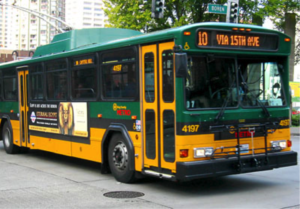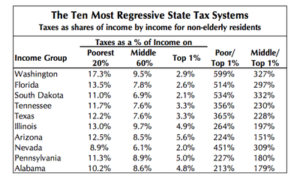
Buses. Are. Amazing.
Buses may seem like an eyesore and a drain on the economy to someone who doesn’t understand their importance, but for those who use them or understand their value, it’s easy to see how much they mean. Buses get people to work. They get people to school. They create independence for seniors and disabled people. They reduce traffic. Buses are hugely important to having a healthy and productive city.
At my first phone bank to fund Seattle’s metro I heard someone say, “The bus is one of the only places that people are together on a daily basis regardless of class, race, and gender.” That idea really means a lot to me. It shows how Metro in Seattle is much more than just a bunch of buses. It’s a force that brings together almost every kind of person that lives and travels in our city.

The awesome #10 Seattle bus goin’ up Pike towards 15th ave.
In the world today there are often very strict barriers between race, class, and gender. These issues are slowly improving but they’re far from over. On the bus everyone sits together . Everyone who takes the bus spends a few minutes of their day in the company of a greatly diverse group of people. There may not be a lot of communication or dialogue but everyone’s still there and together in the same space.
Just being in the same space as others and seeing diverse groups together can help change the way people think about others. I think that just by taking the bus people can become more accepting and understanding of others around them. It may be a small change but even on a very small level this acceptance is critical.
So how should you support this amazingly important cause? By voting yes on Seattle Transportation Prop. 1 on November 4th!
Seattle Transportation Prop. 1 will fund the buses and make them run more smoothly and efficiently. With this measure the bus will be able to reach more people and will better serve our city. Gettin’ people where they need to go. Bringin’ the city together. All good things when it comes to the Seattle buses. And as always, don’t forget to vote.
This blog post was written by Tatum McConnel, sophomore at the Seattle Academy and Communications Coordinator with the 2014 Fall Internship.


 Unfortunately routine budget shortfalls since the beginning of the Great Recession (especially in the state of Washington) have dramatically increased the portion of higher education that students themselves are paying. Where the state used to fund 80 percent (yes, you read that right, eighty!) it is now below 30 percent.
Unfortunately routine budget shortfalls since the beginning of the Great Recession (especially in the state of Washington) have dramatically increased the portion of higher education that students themselves are paying. Where the state used to fund 80 percent (yes, you read that right, eighty!) it is now below 30 percent.


